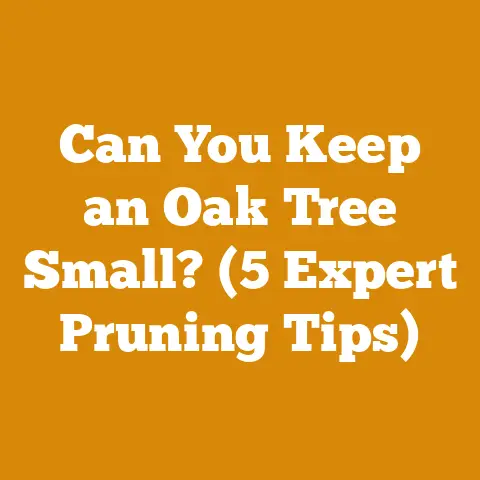Will Roundup Work in Winter for Wood Processing? (5 Key Tips)
Let’s dive into the heart of wood processing, where the rubber meets the road – or rather, where the chainsaw meets the log! There’s a certain primal satisfaction in taking a raw piece of nature and transforming it into something useful, whether it’s firewood to warm a home, lumber for a building project, or even just clearing brush to make way for new growth. But as any seasoned woodworker or logger knows, the devil is in the details. And one of those details, especially for those of us battling unwanted vegetation, is whether or not Roundup, a common herbicide, will actually work its magic during the colder months.
That’s exactly what we’re tackling today: “Will Roundup Work in Winter for Wood Processing? (5 Key Tips).” It’s a question born from practical necessity. I’ve personally been there, staring at a patch of stubborn brush encroaching on my wood pile, wondering if I can save myself some serious elbow grease by spraying it down with Roundup. The answer, as with most things in life, isn’t a simple yes or no. It’s nuanced. And that’s why I’m here to break it down for you, based on my years of experience in the field.
I’m going to share not just the science behind why Roundup might (or might not) work in winter, but also practical tips gleaned from years of battling brush, felling trees, and turning them into something useful. I’ll give you my insights on how to maximize your chances of success, and some alternative strategies to consider if Roundup just isn’t the right tool for the job. Let’s get started!
Roundup in Winter: The Cold, Hard Truth
The core question here is about efficacy. Will Roundup, a glyphosate-based herbicide, actually work when temperatures plummet and plants go dormant? The short answer is: it’s less effective. But let’s dig deeper into the “why” behind that statement.
Why Winter Application is Tricky
Roundup works by being absorbed through the leaves of a plant and then translocating to the roots, effectively shutting down the plant’s ability to produce essential proteins. This process is heavily reliant on active plant metabolism. In winter, most plants enter a state of dormancy. Their metabolism slows down significantly, or even grinds to a halt. This means:
-
Reduced Absorption: Leaves are often waxy or even absent during winter to conserve moisture. This makes it harder for the herbicide to penetrate.
-
Slower Translocation: Even if the herbicide does get absorbed, the plant’s slowed-down metabolism means it won’t be transported to the roots as effectively.
-
Increased Wash-off Risk: Winter often brings rain and snow, which can wash away the herbicide before it has a chance to be absorbed.
Think of it like trying to give medicine to someone who’s in a coma. They’re not actively processing anything, so the medicine is less likely to have the desired effect.
Data Points to Consider
-
Temperature Threshold: Most glyphosate-based herbicides are significantly less effective below 50°F (10°C). Some studies suggest that efficacy drops by as much as 50% when temperatures are consistently below this threshold.
-
Plant Dormancy: Deciduous plants, which lose their leaves in winter, are particularly resistant to Roundup during this period. The herbicide has virtually no entry point.
-
Soil Temperature: Even if the air temperature is mild, cold soil can inhibit root activity and further reduce the herbicide’s effectiveness.
Personal Experience and Insight
I remember one particularly frustrating winter where I was determined to clear a patch of blackberry bushes that were threatening to take over my firewood storage area. I sprayed them down with Roundup on a relatively mild day, thinking I was being proactive. Weeks later, as the weather warmed up, those blackberries sprung back to life with a vengeance. It was a harsh lesson in understanding the limitations of herbicides in winter.
5 Key Tips for Using Roundup in Winter (If You Must)
So, if you’re still determined to use Roundup in winter, despite the challenges, here are five crucial tips to maximize your chances of success.
1. Choose the Right Weather Window
This is paramount. Don’t just spray on any old winter day. You need to find a window of opportunity where conditions are as favorable as possible.
-
Temperature: Aim for days where the temperature is consistently above 50°F (10°C) for at least several hours. Ideally, you want a few consecutive days of warmer weather.
-
Rainfall: Avoid spraying if rain or snow is expected within 24-48 hours. You need to give the herbicide time to be absorbed before it gets washed away.
-
Wind: Choose a calm day to prevent drift. You don’t want to accidentally spray desirable plants or contaminate nearby areas.
-
Sunlight: A sunny day can help warm the plants and potentially increase their metabolism, improving absorption.
Data Point: Studies have shown that glyphosate absorption can increase by 20-30% on sunny days compared to cloudy days.
2. Select the Right Formulation
Not all Roundup formulations are created equal. Some are designed for specific types of plants or conditions.
-
Higher Concentration: Opt for a formulation with a higher concentration of glyphosate. This will increase the amount of herbicide that the plant is exposed to, even if absorption is limited.
-
Adjuvants: Look for formulations that contain adjuvants. These are substances that help the herbicide penetrate the plant’s waxy cuticle (the outer layer of the leaf). Some adjuvants also help the herbicide stick to the plant and resist wash-off.
-
Cold-Weather Specific: Some manufacturers offer formulations specifically designed for cold-weather application. These may contain special adjuvants or other ingredients to enhance effectiveness in colder temperatures.
Example: I’ve had better luck using Roundup Pro Concentrate in winter compared to the standard Roundup Home & Garden formula. The higher concentration seems to make a difference.
3. Target Green Tissue (If Any)
Remember, Roundup needs to be absorbed through the leaves. If the plant has lost all its leaves, you’re essentially spraying water on a stick.
-
Evergreens: Evergreens, such as pine and juniper, retain their needles throughout the winter. These are prime targets for Roundup application.
-
Early Sprouting Weeds: Some weeds, like chickweed and henbit, can sprout early in the winter, especially in milder climates. These are also good targets.
-
Basal Bark Treatment: If the plant has woody stems but no leaves, consider a basal bark treatment. This involves spraying the herbicide directly onto the lower portion of the stem, where it can be absorbed through the bark. This is more effective with certain herbicides specifically designed for this purpose.
Case Study: I successfully controlled a patch of creeping Charlie in my lawn one winter by targeting the small amount of green foliage that remained. I used a selective herbicide specifically designed for lawns, but the principle is the same: target the green tissue.
4. Increase Application Rate (With Caution)
While it might be tempting to simply spray more Roundup, this isn’t always the best approach.
-
Follow Label Instructions: Always follow the label instructions carefully. Exceeding the recommended application rate can damage desirable plants and harm the environment.
-
Spot Treatment: Instead of blanket spraying, focus on spot treating individual plants. This will minimize the amount of herbicide you use and reduce the risk of off-target damage.
-
Consider a Second Application: If the initial application doesn’t seem to be working, consider a second application a few weeks later, when the weather is warmer and the plants are more active.
Warning: Overuse of herbicides can lead to herbicide resistance in weeds. This means that the weeds will become immune to the herbicide, making them even harder to control.
5. Combine with Other Methods
Roundup alone may not be enough to effectively control weeds in winter. Consider combining it with other methods, such as:
-
Manual Removal: Pulling weeds by hand is a labor-intensive but effective way to remove them, especially if you only have a small area to clear.
-
Mulching: Applying a thick layer of mulch can suppress weed growth by blocking sunlight and preventing seeds from germinating.
-
Cutting or Mowing: Cutting or mowing weeds can prevent them from spreading and producing seeds. This is a good option for larger areas.
-
Prescribed Burning: In some cases, prescribed burning can be used to control weeds and clear brush. This is a specialized technique that should only be performed by trained professionals.
Personal Insight: I often combine Roundup with manual removal. I’ll spray the weeds to weaken them, then come back a few days later and pull them out by hand. This makes the job much easier.
Alternative Strategies for Winter Weed Control
If Roundup isn’t the best option for your winter weed control needs, don’t despair. There are several alternative strategies you can consider.
1. Pre-Emergent Herbicides
Pre-emergent herbicides are designed to prevent weed seeds from germinating. They are typically applied in the fall or early winter to prevent weeds from sprouting in the spring.
-
Mechanism of Action: Pre-emergent herbicides work by creating a barrier in the soil that prevents weed seeds from developing roots.
-
Target Weeds: They are most effective against annual weeds, which germinate from seed each year.
-
Application Timing: Apply pre-emergent herbicides before the ground freezes.
Example: I use a pre-emergent herbicide in my garden each fall to prevent crabgrass from sprouting in the spring.
2. Mechanical Control
Mechanical control involves physically removing or suppressing weeds.
-
Tilling or Cultivating: Tilling or cultivating the soil can kill existing weeds and prevent new ones from sprouting. This is best done in the fall, after the growing season is over.
-
Smothering: Covering weeds with a tarp or other material can smother them and prevent them from growing. This is a good option for small areas.
-
Solarization: Covering the soil with clear plastic during the summer can heat the soil to lethal temperatures, killing weeds and weed seeds.
Data Point: Studies have shown that solarization can reduce weed populations by up to 90%.
3. Cultural Practices
Cultural practices involve modifying the growing conditions to favor desirable plants over weeds.
-
Proper Watering: Avoid overwatering, which can create ideal conditions for weed growth.
-
Fertilizing: Fertilize your plants regularly to help them outcompete weeds.
-
Soil Amendments: Amend the soil with compost or other organic matter to improve drainage and fertility.
-
Crop Rotation: Rotate your crops each year to prevent weeds from building up in the soil.
Personal Tip: I’ve found that adding a thick layer of wood chips around my trees and shrubs helps to suppress weed growth and retain moisture.
4. Natural Herbicides
Natural herbicides are made from plant-based or mineral-based ingredients. They are generally less toxic than synthetic herbicides, but they may also be less effective.
-
Vinegar: Vinegar can kill weeds by drying out their leaves. It is most effective on young weeds.
-
Salt: Salt can kill weeds by drawing moisture out of their roots. Be careful not to use too much salt, as it can damage the soil.
-
Corn Gluten Meal: Corn gluten meal is a pre-emergent herbicide that prevents weed seeds from germinating.
-
Citrus Oil: Citrus oil can kill weeds by disrupting their cell membranes.
Caution: Natural herbicides can still be harmful to desirable plants. Use them carefully and follow the label instructions.
5. Goats (Seriously!)
If you have a large area to clear, consider renting goats. Goats are voracious eaters and will happily devour weeds and brush.
-
Benefits: Goats are environmentally friendly and can clear large areas quickly.
-
Considerations: You will need to provide a fence to keep the goats contained.
-
Availability: Goat rental services are becoming increasingly popular.
Unique Insight: I’ve seen goats used to clear brush in parks and on farms. They are surprisingly effective!
Wood Species and Weed Control: A Symbiotic Relationship
The type of wood you’re processing can also influence your weed control strategies.
-
Hardwoods vs. Softwoods: Hardwoods, like oak and maple, tend to create denser shade than softwoods, like pine and fir. This shade can help suppress weed growth.
-
Allelopathy: Some trees, like black walnut, produce chemicals that inhibit the growth of other plants. This is known as allelopathy.
-
Wood Chip Mulch: Using wood chips from certain species as mulch can also have weed-suppressing effects.
Data Point: Studies have shown that wood chip mulch can reduce weed populations by up to 75%.
Safety First: Protecting Yourself and the Environment
No matter which weed control method you choose, safety should always be your top priority.
-
Read the Label: Always read and follow the label instructions for any herbicide or other product you use.
-
Wear Protective Gear: Wear gloves, eye protection, and a respirator when applying herbicides.
-
Avoid Drift: Avoid spraying herbicides on windy days to prevent drift.
-
Protect Water Sources: Do not apply herbicides near water sources.
-
Dispose of Properly: Dispose of empty herbicide containers properly.
-
Be Aware of Wildlife: Be aware of wildlife in the area and take steps to protect them.
Personal Story: I once accidentally sprayed herbicide on a patch of wildflowers. It was a painful reminder of the importance of being careful and paying attention to what you’re doing.
Conclusion: Winter Weed Control – A Strategic Approach
So, will Roundup work in winter for wood processing? The answer is a qualified “maybe.” It’s certainly less effective than during the growing season, but with careful planning and the right techniques, you can still achieve some level of control. Remember to:
- Choose the right weather window.
- Select the right formulation.
- Target green tissue.
- Increase application rate with caution.
- Combine with other methods.
And don’t forget to consider alternative strategies, like pre-emergent herbicides, mechanical control, cultural practices, and natural herbicides.
Ultimately, successful winter weed control is about taking a strategic approach. It’s about understanding the limitations of herbicides and using them wisely, in conjunction with other methods, to achieve your goals.
Now, armed with this knowledge, you can tackle those winter weeds with confidence and keep your wood processing operations running smoothly all year round! Remember, a little planning and effort now can save you a lot of headaches later. Now, get out there and make some sawdust!






